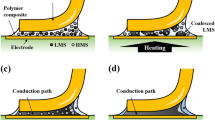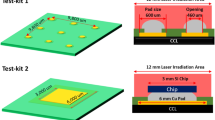Abstract
A novel bonding system for a solderable epoxy composite (SEC) containing a mixed low-melting-point solder (LMS) and high-melting-point solder (HMS) filler (LH-SEC) was proposed to overcome the thermal and mechanical limitations of SECs with LMS fillers. To evaluate the influence of the LMS/HMS mixing ratio on the wetting properties (i.e., the wettability and selective patterning) of the resulting LH-SEC, six types of LH-SEC with different LMS/HMS mixing ratios (100:0, 80:20, 50:50, 20:80, 10:90, and 0:100) were synthesized, and planar and line pattern wetting tests were conducted. The LH-SEC with only the HMS filler exhibited very weak wetting properties because of the excessive curing of the epoxy composite before the HMS melted. In contrast, two wetting modes were observed for the LH-SECs that contained both LMS and HMS. In the LH-SEC with less HMS than LMS, conduction paths were established via the internal flow, integration, and wetting behaviors of the molten LMS containing solid-state HMS within the melting temperature (Tm) range of the LMS filler. For the LH-SECs with more HMS than LMS, conduction paths were formed via the wetting behavior of the molten HMS filler at a temperature range lower than the typical Tm range of the HMS filler because of the decreased Tm of HMS due to the wetting of the molten LMS to the HMS and the diffusion of Bi atoms into the interior of the HMS filler.












Similar content being viewed by others
Data availability
The datasets used or analyzed during the current study are available from the corresponding author on reasonable request.
References
H.K. Kim, F.G. Shi, Microelectron. J. 32, 315–321 (2001)
M.J. Yim, K.W. Paik, Int. J. Adhes. Adhes. 26, 304–313 (2006)
D. Wojciechowski, J. Vanfleteren, E. Reese, H.W. Hagedorn, Microelectron. Reliab. 40, 1215–1226 (2000)
R. Aradhana, S. Mohanty, S.K. Nayak, Int. J. Adhes. Adhes. 99, 102596 (2020)
S. Xu, D.A. Dillard, J.G. Dillard, Int. J. Adhes. Adhes. 23, 235–250 (2003)
B.S. Yim, J.M. Kim, S.H. Jeon, S.H. Lee, J. Kim, J.G. Han, M. Cho, Mater. Trans. 50, 2649–2655 (2009)
B.S. Yim, J.I. Lee, Y. Heo, J. Kim, S.H. Lee, Y.E. Shin, J.M. Kim, Mater. Trans. 53, 2104–2110 (2012)
B.S. Yim, Y. Kwon, S.H. Oh, J. Kim, Y.E. Shin, S.H. Lee, J.M. Kim, Microelectron. Reliab. 52, 1165–1173 (2012)
F. Wang, Y. Huang, Z. Zhang, C. Yan, Materials 10, 920 (2017)
F.Q. Hu, Q.K. Zhang, J.J. Jiang, Z.L. Song, Mater. Lett. 214, 142–145 (2018)
R. Xu, Y. Liu, H. Zhang, Z. Li, F. Sun, G. Zhang, J. Electron. Mater. 48, 1758–1765 (2019)
Y. Liu, H. Fu, H. Zhang, F. Sun, X. Wang, G. Zhang, J. Mater. Sci.: Mater. Electron. 28, 19113–19120 (2017)
A.M. Delhaise, D.D. Perovic, J. Electron. Mater. 47, 2057–2065 (2018)
J.H. Hwang, J.H. Lee, Appl. Surf. Sci. 454, 227–232 (2018)
Y.A. Shen, S. Zhou, J. Li, C. Yang, S. Huang, S. Lin, H. Nishikawa, Mater. Des. 183, 108144 (2019)
M.L. Huang, L. Wang, Metall. Mater. Trans. A 36, 1439–1446 (2005)
Acknowledgements
This research was supported by the National Research Foundation of Korea (NRF) grant funded by the Korea government (MSIT) (No. 2022R1A2C1012409 and No. 2022R1A2C1010405).
Funding
This research did not receive any specific grant from funding agencies in the public, commercial, or not- for-profit sectors.
Author information
Authors and Affiliations
Contributions
MJH: conceptualization, methodology, investigation and writing the original draft; JIL: visualization and investigation; JMK: supervision and validation; BSY: supervision and validation.
Corresponding authors
Ethics declarations
Conflict of interest
The authors declare that they have no known competing financial interests or personal relationships that could have appeared to influence the work reported in this paper.
Additional information
Publisher’s Note
Springer Nature remains neutral with regard to jurisdictional claims in published maps and institutional affiliations.
Rights and permissions
Springer Nature or its licensor (e.g. a society or other partner) holds exclusive rights to this article under a publishing agreement with the author(s) or other rightsholder(s); author self-archiving of the accepted manuscript version of this article is solely governed by the terms of such publishing agreement and applicable law.
About this article
Cite this article
Ha, M.J., Lee, J.I., Kim, JM. et al. Mechanisms for the formation of conduction paths in a solderable epoxy composite with a mixed low- and high-melting-point solder filler. J Mater Sci: Mater Electron 34, 890 (2023). https://doi.org/10.1007/s10854-023-10324-x
Received:
Accepted:
Published:
DOI: https://doi.org/10.1007/s10854-023-10324-x




